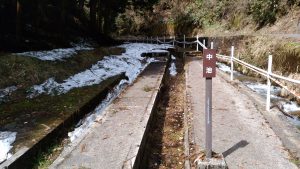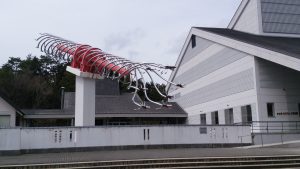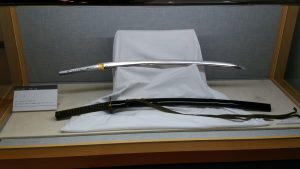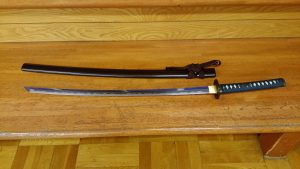神話と日本刀の故郷、出雲へ①/Journey in Izumo, hometown of Mythology and Samurai sword①
日本刀発祥のたたら製鉄の聖地へ
春分の日の直前に2日ほど休みをとって島根県に出かけました。島根県は出雲の国、古事記や風土記では日本の創世の地、独創的な国造り神話が息づく地域です。同時に日本独自の製鉄法「たたら製鉄」の発祥の地でもあり、古代の製鉄所が点在していた奥出雲の地はアニメ「もののけ姫」に登場する「タタラ場」のモデルになったところ(アシタカと戦うエボシ御前が支配する古代の製鉄所)。真剣を扱う身としては、日本独自の日本刀を産みだした現場をぜひ見ておきたいとの想いから、まずは奥出雲にある「たたらと刀剣館」に向かうことになりました。どのガイドブックにも載っていない実にマイナーな場所ですが、個人的には実に勉強になった場所でした。
Pilgrimage to Okuizumo:Origin place of sword steel
I took 2 days off before National holiday in March to travel to Shimane. Shimane Prefecture is ancient land of Izumo, the stage of land creation mythology. At the same time Izumo is the place of the origin of Japanese unique steel manufacturing, named “Tatara iron manufacturing”. You can still find many ruins of ancient iron furnace in the area. This area is the model of “Tatara-ba” in animation film “Princess Mononoke” (Ghibli) where is ruled by Eboshi lady. I own real Samurai sword and exercise Iai-do every week. I have no reason to avoid this origin land. So my first destination is “Tatara to Touken kan (Tatara iron and sword museum)” in deep Izumo. Although it is a minor tourism place which I could not find in any guide books, it became personally quite significant place for me.
(English text continues to the latter half of the page)

日曜の午前中に米子空港に到着、まずは空港でレンタカーを借ります。ここから3日間の相棒がこの車。結局3日で400km近くを走りました。


米子空港から奥出雲に入ると、小さな峠道の入り口に小さく「鉄穴(かんな)流し」の看板が目に留まりました。思わず道草をして寄ってみると、古来から使われていた砂鉄精選場の跡でした。日本独自のたたら製鉄は砂鉄からの精錬、その砂鉄を土中から選り分けるために山を切り崩して土砂を川の流れに落として川の流れの破砕力を利用して石と砂鉄を分離し、さらにその経路に比重の重い砂鉄を溜めるための設備を各所に設けて砂鉄を採集するのが「鉄穴流し」。大規模に山を切り崩すことは現代なら環境破壊の誹りを受けるのですが、当時の山崩しの後は今は棚田が広がる田園風景になっています。
「奥出雲たたらと刀剣館」に到着
昼過ぎには「奥出雲たたらと刀剣館」に到着。八岐大蛇(ヤマタノオロチ)を象ったオブジェが出迎えてくれます。


日本人にはお馴染みの八岐大蛇ですが、ここで外国の方のために少し解説を。八岐大蛇は日本の最初の公式歴史書「古事記」に出てくる出雲に巣食う怪物で、巨大な蛇の体から8本の頭が生えている。どこか巨大なメデューサを思わせる造形。八岐大蛇は郷に住む美しい8人の娘を毎年一人ずつ食べてしまい、遂に今年は末の櫛名田比売(クシナダヒメ)を食いに来るものと思われていた。そこに現われたのが高天原を追放された須佐之男命(スサノオノミコト)。彼は櫛名田比売との結婚を条件にして八岐大蛇退治を約束し、八つの甕に酒を満たし大蛇を酔っぱらわせて遂に怪物退治に成功する。こうしたくだりはいかにもギリシャ神話で、アンドロメダ姫のために海の怪物ポセイドンを倒したペルセウスの物語を思い起こさせます。そして八岐大蛇を退治した後に怪物の尾から剣が見つかります。これが天皇家の三種の神器のひとつ「天叢雲剣(あめのむらくものつるぎ)」になります。
一説では八岐大蛇はこの地方を流れる斐伊川がしばしば洪水を起こし、その“暴れ川”としてのイメージを投影したものと言われます。ただ怪物の頭の爛々と赤く輝く目は、真っ赤に溶ける鉄の塊もイメージさせます。さらに斐伊川がたびたび氾濫したのも、砂鉄を採取するために山を崩し、製鉄のための炭を採るために木を乱獲して山の保水力が低下したため。八岐大蛇伝説は我が国における鉄の黎明期と密接に繋がっています。


日本独自の「たたら製鉄」のイラストが左の写真、右の写真は炉の切断面。粘土で人の背丈ほどの炉を作り、その中に炭と砂鉄を交互にミルフィーユのように積み重ねます。

さらに写真のような鞴(ふいご)で風を送りながら70時間にわたって炉熱を上げ続けます。その間に砂鉄に含まれた不純物は炉下部のドレインから排出されて(多くの不純物は鉄よりも融点が低いため)、炉の内部では炭の炭素と鉄が適度に結合した「鉧(けら)」という鉄分の塊が炉の底から取り出されます。この塊の一部に「玉鋼(たまはがね)」と呼ばれる理想的な鉄と炭素の結合比率を持った部分が含まれており、この玉鋼が日本刀の原材料になります。確かに玉鋼は刀剣にとって世界でも類を見ない良質の材料とは言え、ほんの一握りの玉鋼を得るために巨大な鉄塊を取り出すわけだからこれはいかにも効率が悪い。明治維新になって近代的な製鉄所建設に押されてたたら製鉄が廃れてしまったのがよくわかります。ちなみに現代では日本刀作成の原材料供給のために、地元の保存会がきわめて小規模にたたら製鉄を続けているそうです(非公開)。

この玉鋼からこのような日本刀が制作されます。単なる武器ではなくもはや芸術品。ちなみに西洋の刀は型に溶かした鉄を流し込む「鋳造」方式で制作されますが、日本刀の場合は熱して柔らかくなった鉄を何度も槌(つち)で叩いて鍛える「鍛造」方式で作成します。純粋な鉄の融点は1,600℃あまりで、作刀に使われる炭素含有の鉄は1,400℃あまりで溶解します。実は西洋にはコークスがあったのでこの温度帯を実現することができたことで「鋳造」方式が可能になりました。ところが古代の日本では高温を実現できるものは炭しかなく、鞴で燃焼効率を高めても1,200℃あまりが精いっぱい、この温度では鉄を完全に溶かすことは出来ず、そのために鉄塊を真っ赤に熱したところを槌で叩いては切れ目を入れて折り返すことを繰り返す独自の「鍛造」方式が発展しました。通常の作刀では叩いては折り返すを15回繰り返すそうです。さて、それではここで問題。二つに折り返すことを15回続けた場合、最終的にその鉄は何層構造になるでしょうか・・・・。電卓で「2×2×2・・・」と言った計算を15回繰り返すと答えが出ます。正解は「3万2,768」層!この無限に重なる層が美しい刃紋として表れるわけで、さらに相当の衝撃にも曲がらず折れない強靭な日本刀の刀身が出来上がります。このように独自に発展した日本刀の製法は、『資源の欠乏がイノベーションを生み出した』好例だったように感じます。

これは珍しい!日本刀の断面になります。写真でははっきりとはわかりませんが、独特の多層構造をみることができます。
日本刀制作の詳細については奥出雲町がまとめた以下のURLをご参照ください。
http://www.okuizumo-tatara-pj.jp/tatara/
http://www.okuizumo-tatara-pj.jp/tatara/002.html

ちなみにこれが自分の使っている真剣、価格は軽自動車1台分くらい。実際に毎週稽古の度に巻き藁を切っていますので、造りのしっかりした現代刀です。
実際にこの刀で巻き藁を斬っているのがこの動画になります。奥出雲に始まり千年以上にわたって伝えられてきた日本刀の製法によって自分の居合道も成り立っていることをあらためて感じた旅でした。
次回は出雲大社参詣からお話を始める予定です。
Pilgrimage to Okuizumo:Origin place of sword steel
I took 2 days off before National holiday in March to travel to Shimane. Shimane Prefecture is ancient land of Izumo, the stage of land creation mythology. At the same time Izumo is the place of the origin of Japanese unique steel manufacturing, named “Tatara iron manufacturing”. You can still find many ruins of ancient iron furnace in the area. This area is the model of “Tatara-ba” in animation film “Princess Mononoke” (Ghibli) where is ruled by Eboshi lady. I own real Samurai sword and exercise Iai-do every week. I have no reason to avoid this origin land. So my first destination is “Tatara to Touken kan (Tatara iron and sword museum)” in deep Izumo. Although it is a minor tourism place which I could not find in any guide books, it became personally quite significant place for me.

I arrived in Yonago Airport on Sunday morning and rent a car there. This car is my partner for next 3 days. I drove almost 400km during the trip.
I happened to find small sign board on the way to the museum written “Kanna-Nagashi”. I made small detour to the place. Kanna-Nagashi (Iron cave flow) is an ancient iron sand collection facility. In order to collect iron sand from sediment and stones, people leveled mountains and dropped huge amount of sediment into river flow. Heavy sand iron is stored in pools on each curve. It had been mass environmental destruction to destroy hills in these days. Nowadays fields destroyed by Kanna-Nagashi has been used for rice terrace and become beautiful pastoral scenery.


Arrived at the Museum
We arrived at the Museum early in the afternoon. A huge Objet ”Yamata-no-Orochi (Dragon serpent monster which has 8 heads in the mythology)” welcomed us.


Yamata-no-Orochi is quite familiar with Japanese nationals but I will make a brief explanation for non-Japanese people. Yamata-no-Orochi is a monster in “Kojiki”, the first official history book of Japanese Imperial government. It has a giant dragon-serpent body and it has 8 heads like Medusa. There were 8 beautiful sisters in the village and this monster came down to the village once a year to eat each sister. The monster had eaten already 7 of them and that year was the turn of the youngest sister. Susano-no-Mikoto, a prince of Takama-ga-hara (meaning High heaven field), visited the village and promised the parents to save the youngest daughter named Kushinada-Hime for the right to marry with her. It really reminds me of the story of Perseus who brought down Poseidon for Princess Andromeda. Anyway he prepared 8 big jars filled with Sake and made the monster drunke before finally succeeding in killing it. After the monster was down, Susano found iron made sword in its giant tail. This is one of the 3 Imperial treasure, Ame-no-Murakumo-no-Tsurugi (meaning Heavenly gathering of clouds sword).
Yamata-no-Orochi is said to be an allegory of Hii river which caused flood so often and is known as “Violent river”. But the red glaring eyes of the monster remind us of molten iron. Moreover Hii river caused flood because mountains and cliffs had been destroyed by Kanna-Nagashi and the mountains’ water retention capacities became poor due to reckless deforestation for charcoal production for the purpose of iron manufacture. Yamata-no-Orochi mythology is very closely related with the dawn of iron manufacturing in Japan.


The picture above is an illustration of Japanese original “Tatara iron manufacturing”. Right one is the section of the Tatara furnace. With approximately the height of a f human, the clay built furnace is layers of charcoal and sand iron like a Millefeuille.

Then the bellows like the one in the photo above blow wind for 70 hours to heat the furnace. During this process impurities from the iron sand flow out from drains just at the bottom of the furnace. And a mass of iron is extracted from the bottom of the furnace. Just a piece of this big mass is Tama-Hagane (meaning precious steel) which is the ideal combination of iron and carbon. Tama-Hagane is known as the best material for Japanese sword. However the proportion of Tama-Hagane is quite amall and it is not surprising that this inefficient iron manufacturing quickly faded away after modern iron furnaces were introduced by Meiji Restoration 150 years ago. Nowadays this ancient style of Tatara is operated for modern sword manufacturing by the heritage committee (closed to public).

From this Tama-Hagane Japanese swords such as the one in the photo are produced. This is not only a weapon but beautiful art object. In the Western world, a sword is produced through casting but a Japanese sword is produced through forging. Melting point of iron designated for sword is around 1,400℃. In Europe artisans could realize this level of heating as they had coke but there was only charcoal and bellows in Japan in 6th century and it could reach only to 1,200℃ which is not enough to melt down iron. So sword artisans had to hammer softly-melted iron with hammers and after hammering they fold the iron bar into half and heat it and hammer again. They repeat this process 15 times. Then how many layers does final sword have? This is a simple calculation like 15 times of “2×2×2・・・”. The answer is 32,768 layers! This multi-layer structure makes a beautiful pattern on the sword blade. Also it makes the blade unbendable and unbreakable a tenacious Japanese sword. I believe this is the best example of the fact that “Lack of resources generates Innovation”.
–

This is quite a rare exhibition! A cross section of Japanese sword. You can observe the unique multi- layer structure.
As for details of Japanese sword production, please refer to the URL below prepared by Oku-Izumo town (Sorry! Japanese only)
http://www.okuizumo-tatara-pj.jp/tatara/
http://www.okuizumo-tatara-pj.jp/tatara/002.html

Incidentally this is my sword. It is as expensive as small sized car. This is modern produced and very tough blade as I’m cutting Makiwara (bundle of Tatami mat surface) every week by this.
This movie shows how the sword cuts objects. I realize that I stand on the basis of thousand years history of iron manufacturing and sword production originated in Oku-Izumo.
Next time I will start from Izumo-Taisha (Izumo shrine), the origin of land creation mythology.
